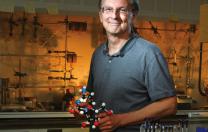Scientists who work with Jack Szostak praise him for an uncommon willingness to cross disciplinary boundaries. Phillips professor of astronomy Dimitar Sasselov, director of the Harvard Origins of Life Initiative (see “Life’s Beginnings,” September-October 2013, page 29), was introduced to Szostak by mutual friends more than a decade ago. Sasselov had recently started studying exoplanets, which orbit sun-like stars in other solar systems. “An obvious question was ‘What about life?’” Sasselov remembers. “How do we search for it? How do we know it’s there?” He began to think about the origins of life on early Earth as a means of pinpointing other planets that could support life. After he and Szostak realized their shared interests, they worked with colleagues including Andrew Knoll, Fisher professor of natural history and professor of earth and planetary sciences, to write a proposal for the Origins of Life Initiative, winning seed money from the University to launch it in 2006.
“Szostak really is the perfect person to work with, because he meets you half way,” Sasselov explains. “He’s a renaissance type, very curious in everything, and tries to understand as much as he can. He would never say, ‘You don’t have to explain to me how it works, just tell me what to do.’ That’s not his style at all.” John Sutherland of the Medical Research Council Laboratory of Molecular Biology in Cambridge, England (where James Watson and Francis Crick first discovered DNA’s double-helix structure), is an organic chemist who also studies the origins of life. He agrees about Szostak’s willingness to branch out beyond his original expertise in biochemistry. “I used to think I had the edge on him in organic chemistry, but then he learned it to the extent that he’s almost a card-carrying chemist as well as a biochemist,” Sutherland notes. “He’s able to make these new contributions because he’s embraced these new subject disciplines.”
The Harvard Origins of Life Initiative was designed to connect researchers from different disciplines across campus, and Sasselov the astrophysicist and Szostak the biochemist reveal what this approach can yield. They visit one another’s labs weekly and influence each other’s work. Sasselov’s research has evolved, he says, from astronomy to “something more like chemistry,” using his knowledge of astronomy and planetary science to determine how ultraviolet (UV) radiation, temperature, and molecules that came through the atmosphere from space into, say, lakes or ponds, might have worked together to synthesize the building blocks of life. One of Sasselov’s astronomy graduate students, Zoe R. Todd, who conducts her research in Szostak’s lab, published a paper last year that showed that the combination of cyanide and copper, when irradiated by UV rays on early Earth, could have produced the sugars needed to assemble RNA chains. “Every year we actually get even more integrated,” Sasselov says.
Szostak has fostered collaborations like this outside Harvard as well. In 2011 philanthropist and billionaire investment-fund manager Jim Simons convened a meeting about underfunded areas of science, and invited Szostak to give a brief talk on his research. This led to a one-day workshop on the origins of life, and soon after, Szostak and Sasselov became co-directors of the Simons Collaboration on the Origins of Life (SCOL), which infused the field with new funding. Members of the collaboration, from fields including chemistry, astrophysics, geology, and field chemistry, gather three times a year in New York to share ideas and findings.
John Sutherland, who is co-director of SCOL, says these meetings have been fruitful because of the atmosphere Szostak had a hand in creating, which emphasizes giving members a high-level education about each other’s disciplines. It has been a “very, very friendly, open environment where people felt they could ask stupid questions,” he says. For his part, Szostak explains that his goal is to give participants a common language, and the opportunity for intelligent conversation. “We’re all specialists in our own fields, but we have to learn how to talk to each other, and to get up to speed on some level in all these other fields.”
Science is competitive, but researchers who might compete with Szostak see him as a friend who is happy to support other smart, rigorous work. “He’s a magnet for some incredibly bright young people,” Sutherland says. Alumni of the lab include Jennifer Doudna, known for her fundamental work in developing CRISPR gene-editing technology, and David Bartel of MIT, who studies microRNAs, important for gene regulation. Matthew Powner, associate professor of organic chemistry at University College London, worked as a research fellow in Szostak’s lab in part because he admired Szostak’s commitment to following his curiosity. “He’s constantly moving on to new challenges that will teach him more,” Powner says. “His group was a great place to learn and think about problems.”







